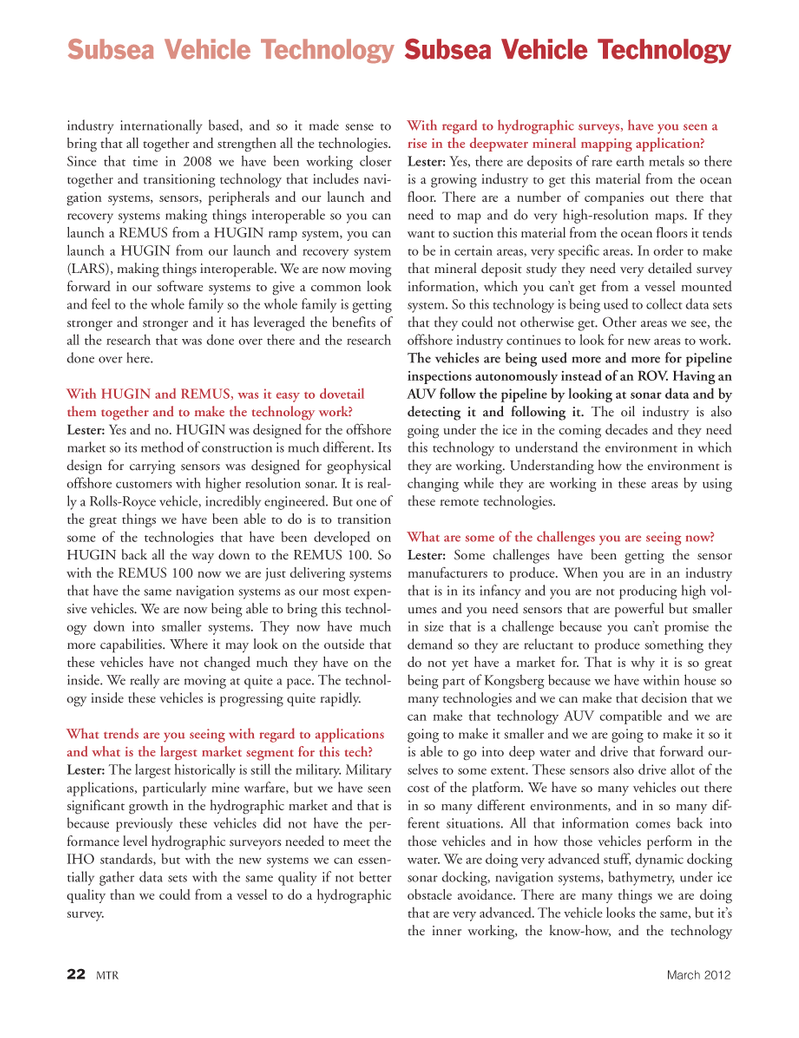
Page 22: of Marine Technology Magazine (March 2012)
Subsea Vehicle Report – Unmanned Underwater Systems
Read this page in Pdf, Flash or Html5 edition of March 2012 Marine Technology Magazine
22MTRMarch 2012 industry internationally based, and so it made sense to bring that all together and strengthen all the technologies. Since that time in 2008 we have been working closer together and transitioning technology that includes navi-gation systems, sensors, peripherals and our launch andrecovery systems making things interoperable so you can launch a REMUS from a HUGIN ramp system, you can launch a HUGIN from our launch and recovery system (LARS), making things interoperable. We are now moving forward in our software systems to give a common look and feel to the whole family so the whole family is gettingstronger and stronger and it has leveraged the benefits of all the research that was done over there and the research done over here. With HUGIN and REMUS, was it easy to dovetail them together and to make the technology work? Lester: Yes and no. HUGIN was designed for the offshore market so its method of construction is much different. Its design for carrying sensors was designed for geophysical offshore customers with higher resolution sonar. It is real- ly a Rolls-Royce vehicle, incredibly engineered. But one of the great things we have been able to do is to transition some of the technologies that have been developed on HUGIN back all the way down to the REMUS 100. So with the REMUS 100 now we are just delivering systems that have the same navigation systems as our most expen- sive vehicles. We are now being able to bring this technol- ogy down into smaller systems. They now have much more capabilities. Where it may look on the outside that these vehicles have not changed much they have on the inside. We really are moving at quite a pace. The technol- ogy inside these vehicles is progressing quite rapidly. What trends are you seeing with regard to applications and what is the largest market segment for this tech?Lester: The largest historically is still the military. Military applications, particularly mine warfare, but we have seen significant growth in the hydrographic market and that is because previously these vehicles did not have the per- formance level hydrographic surveyors needed to meet the IHO standards, but with the new systems we can essen- tially gather data sets with the same quality if not betterquality than we could from a vessel to do a hydrographic survey. With regard to hydrographic surveys, have you seen a rise in the deepwater mineral mapping application? Lester: Yes, there are deposits of rare earth metals so there is a growing industry to get this material from the ocean floor. There are a number of companies out there that need to map and do very high-resolution maps. If they want to suction this material from the ocean floors it tends to be in certain areas, very specific areas. In order to make that mineral deposit study they need very detailed survey information, which you can?t get from a vessel mounted system. So this technology is being used to collect data sets that they could not otherwise get. Other areas we see, the offshore industry continues to look for new areas to work. The vehicles are being used more and more for pipeline inspections autonomously instead of an ROV. Having an AUV follow the pipeline by looking at sonar data and by detecting it and following it. The oil industry is also going under the ice in the coming decades and they needthis technology to understand the environment in which they are working. Understanding how the environment is changing while they are working in these areas by using these remote technologies. What are some of the challenges you are seeing now? Lester: Some challenges have been getting the sensor manufacturers to produce. When you are in an industry that is in its infancy and you are not producing high vol- umes and you need sensors that are powerful but smaller in size that is a challenge because you can?t promise the demand so they are reluctant to produce something they do not yet have a market for. That is why it is so great being part of Kongsberg because we have within house so many technologies and we can make that decision that we can make that technology AUV compatible and we are going to make it smaller and we are going to make it so it is able to go into deep water and drive that forward our- selves to some extent. These sensors also drive allot of the cost of the platform. We have so many vehicles out there in so many different environments, and in so many dif- ferent situations. All that information comes back into those vehicles and in how those vehicles perform in the water. We are doing very advanced stuff, dynamic docking sonar docking, navigation systems, bathymetry, under ice obstacle avoidance. There are many things we are doing that are very advanced. The vehicle looks the same, but it?s the inner working, the know-how, and the technology Subsea Vehicle Technology Subsea Vehicle Technology MTR#2 (18-33):MTR Layouts 2/21/2012 10:46 AM Page 22

 21
21

 23
23
